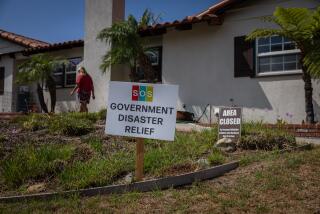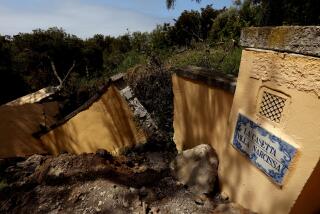Potrero Canyon Fill Report Approved
The Los Angeles Board of Recreation and Parks Commissioners has certified the final environmental impact report on the filling of Potrero Canyon in Pacific Palisades.
The board Friday also approved the concept of filling the canyon and building a trail from the Palisades Recreation Center to Will Rogers State Beach.
But the filling proposal also requires permits from the California Coastal Commission, the state Department of Fish and Game, the Regional Water Quality Control Board, the Army Corps of Engineers and several city agencies, including the Bureau of Engineering and the Planning Department.
Engineering and geological reports must still be completed before the controversial project can go forward.
In approving the project, the Recreation and Parks Commissioners acknowledged that it would dramatically transform a natural canyon into a man-made recreation area, affecting vegetation and wildlife. But commissioners concluded that the project would protect homes and provide beach access, thus overriding the environmental concerns.
The city may have difficulty obtaining Coastal Commission approval. The project conflicts with the state coastal act governing environmentally sensitive habitats and the protection of scenic canyons.
Will Weigh Concerns
And Tom Crandall, the Coastal Commission’s south coast regional director, said his staff will weigh concerns about the environment against the need to protect the homes along the canyon rim.
“If you fill a canyon bottom, obviously any organisms, plant or animal, that are dependent on that area for their existence are no longer able to live in that area,” Crandall said. “The effect in Southern California of the development process has been to greatly diminish the water courses and the associated vegetation and organisms.”
The canyon has been the subject of controversy for several years. Since 1956, at least four proposals have been made to fill the mile-long canyon to protect the 99 homes along its rim. Since 1933, a dozen homes have fallen into the canyon, which is 200 feet deep in some places.
The latest proposal calls for raising the canyon bottom 40 feet with 300,000 cubic yards of material and using bulkheads to stabilize select areas along the canyon. The project would take three years and cost an estimated $1.4 million.
Another proposal, offered in 1972, calls for raising the floor of the canyon by 125 feet, using 2.3 million cubic yards of material. It would take six years and cost $1.9 million.
Earlier in the year, the City of Los Angeles agreed to buy 16 parcels from canyon homeowners for $7.3 million to settle a property damage lawsuit that stemmed from landslides in 1978 and 1980. To avoid further litigation, the city attorney recommended that the city take “immediate action” to construct a drainage system to prevent further erosion in the canyon.
Drainage System
The City Council recently approved $1.1 million for the construction of a drainage system to control the water flow through the canyon, which has been a major cause of the landslides.
Councilman Marvin Braude, who represents the area, said that the fill project is the best way to stabilize the canyon and prevent further landslide damage.
“It’s been a long, difficult project and I’m hopeful that we are making significant progress,” Braude said. “There are lots of steps and lots of public discussion before any project can be approved.”
Braude said the park would “provide a gateway to the ocean (from the Palisades Recreation Center). . . . It will include a bridge across the Pacific Coast Highway so that there will be direct pedestrian access to the beaches without crossing a public street.”
But some residents have expressed concern that the fill be as high as possible to stabilize the canyon walls, and others have said they do not want the park in their backyards.
Frances Shalant, president of the Pacific Palisades Residents Assn., said she is concerned that the project has not been studied carefully enough.
“If the geological study has not been done, how can it be a final environmental impact report?” she asked. “We are not taking a position on the actual desirability of the fill because there are strong feelings on both sides. If it is going to be done, it should be done in the safest and the most thoroughly studied fashion. That hasn’t been done.”
A major concern identified in the environmental report is the disruption of traffic on Pacific Coast Highway during the filling. Dump trucks and construction equipment would be brought in from the highway into the mouth of the canyon. The city hopes to minimize the disruption, according to David M. Attaway, an environmentalist with the Los Angeles Parks and Recreation Department.
Attaway said the fill would also “wipe out the vegetation in the canyon bottom.” Animals would be forced to flee the canyon. But the animals would return after the filling was completed and the vegetation restored, Attaway said.
There was concern that an endangered species, a small olive-gray bird known as the Bell’s least vireo, would be threatened by the fill. But the city conducted a survey in April that concluded the bird would be safe, Attaway said.
More to Read
Sign up for Essential California
The most important California stories and recommendations in your inbox every morning.
You may occasionally receive promotional content from the Los Angeles Times.










